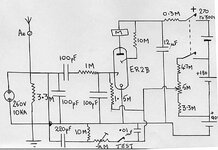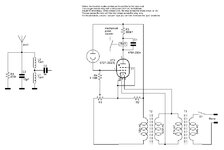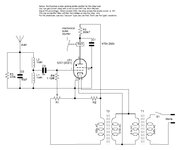neazoi
Advanced Member level 6

Hi I have seen this tube lighting counter https://volcaniclightning.tripod.com/aflashof.htm and I like it.
However the tube is a bit expensive so I searched for what can be made with the 5727 (2d21) as I have plenty of these.
I saw a self-rectifying, self reset circuit attached in the datasheet (page 4).
I wonder how could the input circuit be transformed from the light detector to the antenna-based? Maybe a parallel tunable circuit centered around 1mhz should have sufficient reactance to peak the QRN pulse to trigger the thyratron? But then, how should I connect the parallel tuned circuit in this self-rectifying configuration, where there is no ground? This is what I wonder.
Just directly replace the phototube with this LC?
Also if you have any other such tube circuits to share, please let me know.
However the tube is a bit expensive so I searched for what can be made with the 5727 (2d21) as I have plenty of these.
I saw a self-rectifying, self reset circuit attached in the datasheet (page 4).
I wonder how could the input circuit be transformed from the light detector to the antenna-based? Maybe a parallel tunable circuit centered around 1mhz should have sufficient reactance to peak the QRN pulse to trigger the thyratron? But then, how should I connect the parallel tuned circuit in this self-rectifying configuration, where there is no ground? This is what I wonder.
Just directly replace the phototube with this LC?
Also if you have any other such tube circuits to share, please let me know.





